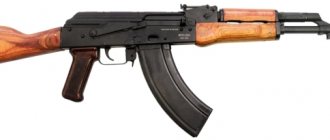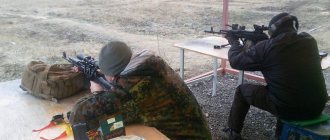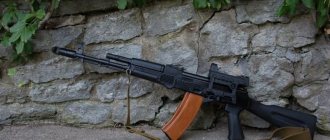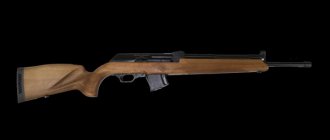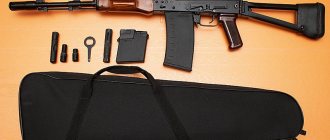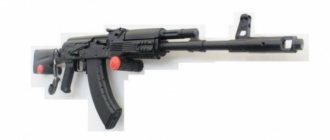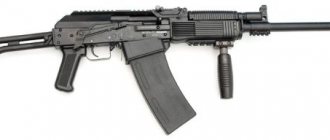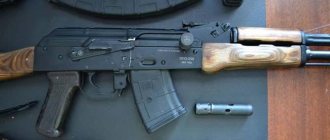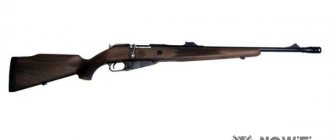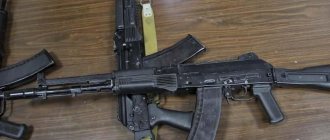The VPO 209 carbine is a smoothbore shotgun created on the basis of a modernized Kalashnikov assault rifle; it is almost no different from the latter - that is why it is sometimes called the “smoothbore Kalashnikov VPO 209”. The ammunition for it is .366 TKM cartridges, which were manufactured for the VPO 208 carbine.
Carbine with magazines
The AKM smoothbore carbine is purchased under a license for weapons with a smooth barrel.
Performance characteristics (TTX) of VPO 209
| Characteristic name | Meaning |
| Caliber | .366 TKM |
| Total length of weapon, mm | 883 |
| Barrel length, mm | 415 |
| Curb weight, kg | 3,2 |
| Sighting range, m | 300 |
| Magazine capacity, cartridges | 10 |
The cartridges used for shooting in the VPO 209 366 TKM shotgun are intended for hunting animals weighing no more than 200 kg. The lethal effect of the bullet remains at a distance of a maximum of 150 meters.
TKM cartridge
The base case for the manufacture of the .336 TKM cartridge is the 7.62×39 mm cartridge case of the 1943 model. The cartridge is equipped with a “Dary” lead bullet weighing 13.5 g. There is also an option with a “Gexa” semi-sheathed bullet, which weighs 15.5 g. Starting from 2016, production of a cartridge with exactly the same bullet with an expansive cavity “Cone” and weighing 15 g has also continued. In addition, VPO 209 cartridges with a semi-jacketed SP 13 bullet and weighing 13 g are being mass-produced.
The original caliber of the cartridge for VPO 209 is 7.62 mm. However, during the development process it was decided to increase the bullet caliber to 9.5 mm.
Civilian long-barreled rifled weapons in Russia. Part 5
The acquisition of rifled long-barreled weapons is permitted to Russian citizens after five years of experience in owning smooth-bore weapons, provided that there are no certain administrative offenses. The procedure for obtaining a license is almost the same as for obtaining a license for a smooth-bore weapon.
The number of models of long-barreled rifled weapons available for purchase by citizens of the Russian Federation is enormous, and is not inferior in variety to smooth-bore long-barreled weapons. Conventionally, the market for rifled long-barreled weapons can, by analogy with smooth-bore weapons, be divided according to several criteria: by manufacturer - domestic/foreign rifled weapons, and by purpose - hunting/sport/self-defense. Although the last point in relation to rifled ones already looks quite specific. Again, by analogy with smooth-bore weapons, there is interchangeability - with the same model you can both hunt and play sports.
I don’t see any point in considering long-barreled rifled weapons from the USSR period - they existed, but their range, compared to the present time, was extremely limited.
Most of the models of long-barreled rifled weapons offered by domestic manufacturers are represented by conversions of AK/RPK/SVD military weapons into civilian models. To achieve this, the possibility of firing in bursts was removed, in some cases the barrels were made with worse ballistic characteristics, and the magazine capacity was limited to ten rounds. Also, “fenced” rifled long-barreled weapons are often produced in several versions - the classic “army” version, or in a wooden stock, ergonomically more convenient for hunting.
The production of rifled long-barreled weapons based on the design of Kalashnikov assault rifles is carried out by the Kalashnikov Concern of the same name. Almost the entire range of products produced by the concern is supplied to the market in civilian versions.
In particular, the Saiga MK series in full-size and shortened versions, chambered for 5.45x39, 7.62x39 and NATO .223 Rem, 308 Win cartridges. .
Full-size SAIGA-MK 5.45 version 30
Shortened SAIGA-MK 7.62 version 33
Sports Saiga-223 “Svarog”
Among the new products, we can note the Saiga version chambered for 9x19 and the version with balanced automatics, which reduces recoil when fired.
Sports Saiga-9 “Yarovit” (cartridge 9x19)
Self-loading Kalashnikov SR1 carbine with balanced automatic action chambered for 223 Rem.
The concern also produces rifled weapons of traditional hunting design, for example, the MP-142K hunting carbine for .223 Rem, 9.3*64, 30-06 Springfield calibers.
Hunting carbine MP-142K
The direct competitor of the Kalashnikov concern is (Vyatskie Polyany). produces civilian rifled long-barreled weapons based on the Kalashnikov light machine gun (RPK) and Kalashnikov assault rifles (AK/AKM).
Carbine VPO-156-18 chambered for 7.62x39 based on AKM
It has a wooden stock and butt, for lovers of the classic AKM design.
Carbine VPO-136 "Vepr-KM"
The VPO-159-08 carbine is supplied complete with three barrels of calibers 7.62x39 (350mm), .366 TKM (420mm), 6.5 Grendel (520mm)
Semi-automatic carbine VPO-102 based on the RPK chambered for the powerful .30-06 Springfield cartridge (7.62×63)
Classic hunting carbine Taezhnik VPO-111 / VPO-111 caliber 7.62x54R with manual reloading with a longitudinally sliding rotary bolt
For history buffs, civilian versions of weapons from the Second World War have been released - PPSh, RPD and others.
Carbine "DP-O" k.7.62x54R
The model range of “Hammer-Weapons” and “Kalashnikov Concern” is rapidly expanding. The cost of weapons produced by these enterprises allows them to be purchased by the majority of the working population of Russia. If new ones are not affordable, then the used market is available to buyers. Of course, there are fewer offers than for smooth-bore weapons, but quite enough.
The Tula Arms Plant has produced a civilian version of the VSS Vintorez - KO VSS silent sniper rifle chambered for the civilian version of the 9x39 cartridge. The muffler, of course, is an imitation.
KO VSS caliber 9x39
The variety of models offered on the long-barreled rifle market has given impetus to the development of small private tuning companies. The kits they produce can significantly improve the characteristics of the weapon being tuned.
[
i]TIGER carbine, tuned with an aluminum stock (chassis) and Vlasenko butt. Implemented a suspended barrel, the ability to install sights and additional equipment
Promtekhnologii has become a relatively new player in the Russian arms market. The company was founded in 2011, equipped with modern equipment, and currently produces a number of high-precision rifled weapons.
The range includes the ORSIS 120 carbine with a longitudinally sliding rotary bolt, which has a fairly affordable price for a weapon of this level of performance.
[
i]ORSIS 120 carabiner
The ORSIS T-5000 precision rifle is available in various calibers, up to .338 LM (Lapua Magnum), and allows operation at a range of up to 1500 meters.
Rifle ORSIS T-5000
The company's new product is the universal tactical self-loading carbine ORSIS-K15 “Brother” chambered for the .308 Win. cartridge, made according to the AR-15 type weapon.
ORSIS-K15 "Brother"
Another company producing precision weapons in Russia is (“KBIS”), offering rifles under the Lobaev Arms brand. The history of rifles of the Lobaev Arms brand begins with the creation, founded by the brothers Vladislav and Nikolai Lobaev in the city of Tarusa (Kaluga region) in 2003. The company developed and manufactured the SVL rifle - the Lobaev Sniper Rifle, a high-precision weapon that uses the powerful .408CT cartridge and allows you to hit a target at a range of over 2000 meters. The SVL rifle was adopted by the Federal Security Service (FSO). On the basis of the SVL, a civilian model OVL (Lobaev Hunting Rifle) was released, which differs from the SVL essentially only in name.
In 2010, they refused to renew the license for the development and production of weapons, and therefore they had to curtail their activities in the Russian Federation. The reasons for this event are shrouded in darkness; there are various versions that readers can find out for themselves on the Internet. The company team, led by the founder, continued to operate in the UAE.
In 2013, the company returned to Russia under the new legal entity “KBIS” and the brand “Lobaev Arms”. The priority of Lobaev Arms is world-class precision weapons. Russian citizens can purchase high-precision weapons with characteristics available only to elite special forces.
For example, SVLK-14S “DUSK”. Cartridge .408CT, accuracy 0.2 arc minutes, firing range over 2500 meters.
SVLK-14S "DUSK"
The Lobaev Arms model range is expanding; the company plans to produce a high-precision long-range semi-automatic in .338 LW (Lobaev Whisper) and .408 LW calibers, available for purchase to citizens of the Russian Federation.
There are also a huge number of foreign-made rifled long-barreled weapons on the market.
An example is such a high-quality weapon as the Blaser Tactical 2 / R93 LRS2, produced by the German company. This weapon is equipped with an original direct-action collet bolt and is available in calibers up to .338 LM
B laser Tactical-2 R93 LRS2
The Blaser R93 rifle is also available in other calibers, including the classic hunting version, for different types of hunting.
The creation of the Blaser R93 was attended by the deputy chief designer for design work of the German company, our compatriot Sergei Vasilyevich Popikov, who emigrated from Russia in the early 90s. Before moving, he worked at the Tula Arms Factory and lived in the entrance of the house next to the author's entrance. One can only guess how many minds flowed away from Russia during the years of perestroika and, perhaps, are flowing away now.
Another interesting model available to citizens of the Russian Federation is the Finnish Sako TRG-42 rifle of .338 LM caliber. This weapon is used by the Special Purpose Center (TsSN) of the FSB and some other intelligence services of the Russian Federation, where it has proven itself well.
Rifle Sako TRG-42 .338 LM DTK 680
Among the manufacturers of inexpensive foreign weapons that can compete with domestic companies, one can name the Czech company CZ, for example, their model CZ-550 “PREDATOR” chambered for the powerful hunting cartridge .30-06 Springfield.
Rifle CZ-550 "PREDATOR" caliber .30-06
As mentioned earlier, the range of rifled long-barreled weapons in Russia is huge, and in order to choose something to your taste, you will have to study the offer on the market, read reviews and testimonials from owners.
The sanctions imposed against Russia have led to the absence of certain calibers of ammunition on the domestic market. Russian factories have mastered the production of some of the inaccessible or poorly accessible calibers, but not all. For example, production of 30-06 Springfield cartridges has begun, and production of .338 LM cartridges is planned. Also, there is often a noticeable gap in the quality of Russian cartridges, compared to foreign ones, which is far from being in our favor.
The absence on the market of cartridges for precision weapons, such as .338 LM, .408CT, or their domestic analogues, is not so much critical for the civilian market of rifled long-barreled weapons, as it is unpleasant from the point of view of state security.
On the other hand, from 2022, citizens are allowed to independently assemble cartridges for rifled weapons, this will allow professional athletes and hunters to obtain better shooting results using self-assembled cartridges.
Let's return to the domestic manufacturer. It would seem that there are weapons on the market for all conceivable tasks of athletes and hunters, but the market may not stop.
The branch of the Tula Instrument Design Bureau - TsKIB SOO presented the large-caliber hunting carbine MTs-558. A manually reloading carbine with a bullpup design, made on the basis of the silent sniper rifle “Vykhlop” chambered for 12.7×55 STs-130, .300 LM, .338 LM caliber cartridges.
Cartridges 12.7×55 STs-130
And finally, the Novosibirsk Cartridge Plant began production of hunting cartridges of 12.7×108 caliber. At the moment, these cartridges are produced only for export.
Export hunting cartridge caliber 12.7×108 mm
However, at the Army-2018 forum, TsKIB SOO director Alexey Sorokin announced the development of a civilian version of the OSV-96 12.7 mm sniper rifle.
OSV-96 is a Russian large-caliber sniper rifle designed to destroy enemy personnel and equipment at long distances. The rifle uses a powerful 12.7x107 mm cartridge (both machine gun and specialized sniper), its sighting range is 1800 m. The OSV-96 magazine capacity is five rounds. The rifle is in service with the Russian Ministry of Defense, the Ministry of Internal Affairs and the FSB.
Large-caliber sniper rifle OSV-96
Rifles of .408CT and 12.7x107 mm calibers can be compared to high-precision guided weapons in terms of firing range and accuracy, as well as to some extent in their effect on the target.
Based on what is presented in the review, we can conclude that Russian citizens can purchase weapons that are not inferior to those used by the army and special services. These are conventionally “assault” weapons, and infantry sniper weapons (marksman), and weapons intended for special operations by special forces units, and the so-called “anti-material” (intended to destroy equipment) weapons.
To improve your skills in using long-barreled rifles, you can take training. For example, “Lobaev Arms” has an offer - “Lobaev Ultra-Long Range Shooting School”, where they teach shooting at a range of over 2000 meters. The courses consist of basic (5 and 10 days) and specialized (from 3 days).
It should be noted that there is a gradual increase in the number of shooting ranges and shooting ranges where owners can legally use their weapons, since hunting, in which the use of rifled weapons is permitted, is not affordable for everyone, and not everyone has the desire to shoot animals.
Apart from rifled short-barreled weapons, the opportunities for Russian citizens to purchase weapons are not much inferior to those of US citizens, and significantly exceed what is available for purchase to citizens of many other countries.
Despite such an impressive arsenal available to citizens of the Russian Federation, there are no military coups or similar events frightening the average person in the country.
Let's hope that this situation does not change in the future. Athletes, hunters and just gun lovers will be able to legally purchase the best examples of the global weapons market.
The design of the shotgun Hammer AKM VPO 209
The VPO 209 single-barreled hunting weapon is designed for use in geographic latitudes where the external temperature remains in the range from minus 50 to plus 50°C. The smoothbore AKM has a barrel length of 415 mm, with a Paradox rifle - six grooves, each of them 12.5 - 13 centimeters long.
The Hammer AKM VPO 209 366TKM gun is reloaded automatically, thanks to the energy of the return spring and the use of the force of powder gases, which, when fired, are diverted from the barrel bore into the gas chamber. The bolt is locked onto two lugs by rotating the bolt around its axis using a longitudinally sliding bolt frame. Thanks to the hammer-type firing mechanism, a single shot is fired and the weapon is put on safety.
The hammer-type trigger mechanism ensures the production of a single shot and setting the safety. The open sight of the gun, in the butt of which there is a pencil case with accessories for its cleaning and disassembly, allows for targeted shooting at distances of up to 300 m.
Photo of VPO 209 with full ammunition
Operating principle when firing a shot:
- When the bolt frame and bolt move forward under the action of the return spring, the cartridge from the magazine is sent into the chamber
- When the bolt is turned, the barrel bore is locked, the trigger is on the trigger hook, the ejector jumps over the rim of the cartridge case
- When you press the trigger, the trigger disengages from the trigger hook and, turning under the action of the mainspring, strikes the firing pin, which pierces the igniter capsule.
VPO-136 – civilian Kalashnikov
“Molot-Weapon” was released as a modified and expanded VPO-133, which has even fewer differences from the machine gun that became the “donor” for this carbine.
Now I would like to talk in a little more detail about exactly how these carbines ended up on the shelves of gun stores. To begin with, the AK (or AKM) left the factory (there were versions from Izhevsk and Tela), after which fate brought it to the USSR Ministry of Defense, where it was safely sent further: to military units, warehouses and other duty stations. This machine gun, regardless of where it ended up, having not yet exhausted its resource, eventually ended up in a warehouse, where it lay idle for a long time until that wonderful moment until the Ministry of Defense of the Russian Federation sold it to a private company. And she, through simple machinations, turned it into a hunting carbine, after which she packaged and “handed over” her products to a weapons store. The most interesting thing is that they sell really different carbines. They may be “slightly used”, which during their entire active career, albeit a lot, have only been worn; and there are also specimens that an experienced hunter would be envious of shooting. The manufacturer doesn’t bother changing the handguards/pads/buttstocks, which makes you feel like you’re in a consignment department when choosing from several copies.
Quite a rare copy of 1951 release
Now about the most interesting thing - the differences between VPO-136 and VPO-133 (an earlier version of the converted AK):
- The ability to use AK magazines without modification has been retained. You just have to take into account that, in accordance with the ZoO, you do not have the right to use magazines that can load more than 10 rounds of ammunition.
- Forensic requirements for civilian weapons were observed with greater loyalty - both for him and for the shooter. Instead of a pin in the VPO-133, the muzzle end of the VPO-136 has a rather neat core (which, among other things, “smoothes out” with an increase in the number of burned ammunition).
- This time the muzzle nozzle is not welded, which allows you to remove it and install nozzles and DTK that are more convenient for a particular shooter.
- Unlike VPO-133, VPO-136 is equipped with “long” AK magazines with a 10-round limiter.
But it is worth noting some features of the VPO-136, which may cause a negative reaction in the potential owner of this carbine:
- One of the main disadvantages of the Vepr-KM for collectors and people who value the authenticity of the carbine with the donor is the absence of a “native” cleaning rod, pencil case and belt in the factory configuration of the carbine. It is not clear why this was done and where the full-fledged pencil cases for cleaning went (no less than they were stolen “over the hill” - they are gold!). Fortunately, Vernissage and similar places are still open and functioning, so purchasing the missing parts is not a big problem.
- The screw securing the buttstock of the HPO is welded to prevent the removal and replacement of the buttstock with, for example, a telescopic one, which took this weapon beyond the total length of 800 mm required by law. The manufacturer is not responsible for the illegal acts of weapon owners regarding violation of the length allowed by law, but here, apparently, the creators decided to play it safe so as not to cast a shadow on themselves.
- Replacement of the “native USM”. This is also an important fact for lovers of aesthetics and non-lovers of “everything new and low-quality,” although in practice such a replacement only results in the absence of automatic fire.
New inscriptions can be removed without much difficulty for experienced collectors
However, another advantage of the Vepr-KM, but this time over the Saiga-MK carbines, is the very coveted “QTK stamp” of Soviet state acceptance for many admirers of Soviet weapons. It is worth noting that finding a VPO-136 that definitely requires fine-tuning is much more difficult than a similar copy of the Saiga-MK, which once again tells us that... well, you know everything yourself.
It is worth saying that the “Vepr-KM” does not have any special collectible or historical value; after all, the weapon was damaged by criminal marks, the trigger was pulled out and replaced with a modern one - the same one that is on other “veprs”. But AK fans, especially AK-47 fans, may like the VPO-136 versions, in which AK “type 2” and AK “type 3” served as donors. The AK has survived to this day, frankly, for a short time, but here was the chance not only to look at it through museum glass, but also to buy, own and shoot.
Pay attention to the shape of the receiver
My humble opinion about Vepr-KM can be described something like this: “This is a breakthrough.” Yes, until the very end I didn’t believe that it was possible in our market for cautious manufacturers to have an AK-based carbine that would be compatible without shamanism with AK magazines, of which there are a huge number on the open market; that it is possible to have a carbine without a pin in the barrel, without abusing the chrome in the chamber, a carbine with high-quality parts that are unlikely to have to be additionally adjusted to each other, experimentally making the weapon somehow shoot. But today I can say that it is quite real. And I am sure that our civilian weapons manufacturers still know how to amaze the public, and VPO-136 is not at all the limit, although for the current stage of development of our weapons society it is a gift. A gift that shooters deserve.
Author: Igor Gunkin
